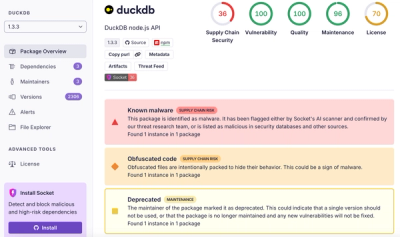
Product
Introducing Tier 1 Reachability: Precision CVE Triage for Enterprise Teams
Socket’s new Tier 1 Reachability filters out up to 80% of irrelevant CVEs, so security teams can focus on the vulnerabilities that matter.
pipenv-to-requirements
Advanced tools
.. image:: https://travis-ci.org/gsemet/pipenv-to-requirements.svg?branch=master :target: https://travis-ci.org/gsemet/pipenv-to-requirements .. image:: https://badge.fury.io/py/pipenv-to-requirements.svg :target: https://pypi.python.org/pypi/pipenv-to-requirements/ :alt: Pypi package .. image:: https://img.shields.io/badge/license-MIT-blue.svg :target: ./LICENSE :alt: MIT licensed
Generate requirements[-dev].txt from Pipfile (using pipenv).
Used in my modern Python module project cookiecutter <https://github.com/gsemet/python-module-cookiecutter>_.
template.
Pipfile and its sibling Pipfile.lock are clearly superior tools defining clear dependencies
or a package. Pipfile is to be maintained by the package's developer while Pipfile.lock
represent a clear image of what is currently installed on the current system, guarantying full
reproductibility of the setup. See more information about Pipfile format here <https://github.com/pypa/pipfile>_. Most of the time, Pipfile.lock should be ignored (ie, not
tracked in your git) for packages published on Pypi.
pipenv <https://github.com/kennethreitz/pipenv>_ is a great tool to maintain Pipfile, but
developers might be stuck with backward compatibility issues for tools and services that still use
requirements.txt and does not know how to handle Pipfile or Pipfile.lock yet.
For examples:
Read the Docs <https://github.com/rtfd/readthedocs.org/issues/3181>_Pyup <https://github.com/pyupio/pyup/issues/197>_ (experimental support is
arriving <https://github.com/pyupio/pyup/issues/197>_ )PBR <https://docs.openstack.org/pbr/latest/>_ (*)pip install (if you install a package with pip that does not have a requirements.txt,
its dependencies won't be installed, even if you use Pipfile)(*): for the moment, I recommend to generate at least requirements.txt (without version
freeze) for the libraries using PBR that you publish on Pypi. Remember PBR automatically synchronize
the content of requirements.txt found at the root of a package with setup.py of this package.
This allows automatic installation of the very dependencies of your package.
Without this file, your package will be installed by pip, but its dependencies will be ignored.
Support in PBR may be added in the future (see this
this patch <https://review.openstack.org/#/c/524436/>_ ).
For build reproductibility, I also recommend to check in your lock file even for libraries, so that your CI won't fail when new packages is published on Pypi.
Just before building source/binary/wheel package of your python module, only of the following commands:
To generate requirements files (ie, dependencies are described eventually by range), typically for libraries:
.. code-block:: bash
pipenv run pipenv_to_requirements
To generate frozen requirements (ie, all dependencies have their version frozen), typically for applications:
.. code-block:: bash
pipenv run pipenv_to_requirements -f
It will generate requirements.txt and, if applicable, requirements-dev.txt, in the current
directory.
Also possible:
.. code-block:: bash
pipenv run pipenv_to_requirements -d requirements-dev-custom.txt
pipenv run pipenv_to_requirements -d requirements-dev-custom.txt -f
pipenv run pipenv_to_requirements -o requirements-custom.txt
pipenv run pipenv_to_requirements -o requirements-custom.txt -f
pipenv run pipenv_to_requirements -d requirements-dev-custom.txt -o requirements-custom.txt -f
Example using a Makefile::
dev:
pipenv install --dev
pipenv run pip install -e .
dists: requirements sdist bdist wheels
requirements:
# For a library, use:
pipenv run pipenv_to_requirements
# For an application, use:
# pipenv run pipenv_to_requirements -f
sdist: requirements
pipenv run python setup.py sdist
bdist: requirements
pipenv run python setup.py bdist
wheels: requirements
pipenv run python setup.py bdist_wheel
Just use make requirements to refresh the requirements.txt.
Simply commit these files in your tree so that Read the Rocs, and ensure they are synchronized each
time you change your Pipfile. Do not forget to ask Read the Docs to use requirements-dev.txt
when building the documentation.
Create your development environment with
.. code-block:: bash
$ make dev
Execute unit tests:
.. code-block:: bash
$ make test
Code formatter:
.. code-block:: bash
$ make style
Code Style Checks:
.. code-block:: bash
$ make check
FAQs
Generate requirements[-dev].txt from Pipfile using pipenv
We found that pipenv-to-requirements demonstrated a healthy version release cadence and project activity because the last version was released less than a year ago. It has 1 open source maintainer collaborating on the project.
Did you know?

Socket for GitHub automatically highlights issues in each pull request and monitors the health of all your open source dependencies. Discover the contents of your packages and block harmful activity before you install or update your dependencies.

Product
Socket’s new Tier 1 Reachability filters out up to 80% of irrelevant CVEs, so security teams can focus on the vulnerabilities that matter.

Research
/Security News
Ongoing npm supply chain attack spreads to DuckDB: multiple packages compromised with the same wallet-drainer malware.

Security News
The MCP Steering Committee has launched the official MCP Registry in preview, a central hub for discovering and publishing MCP servers.